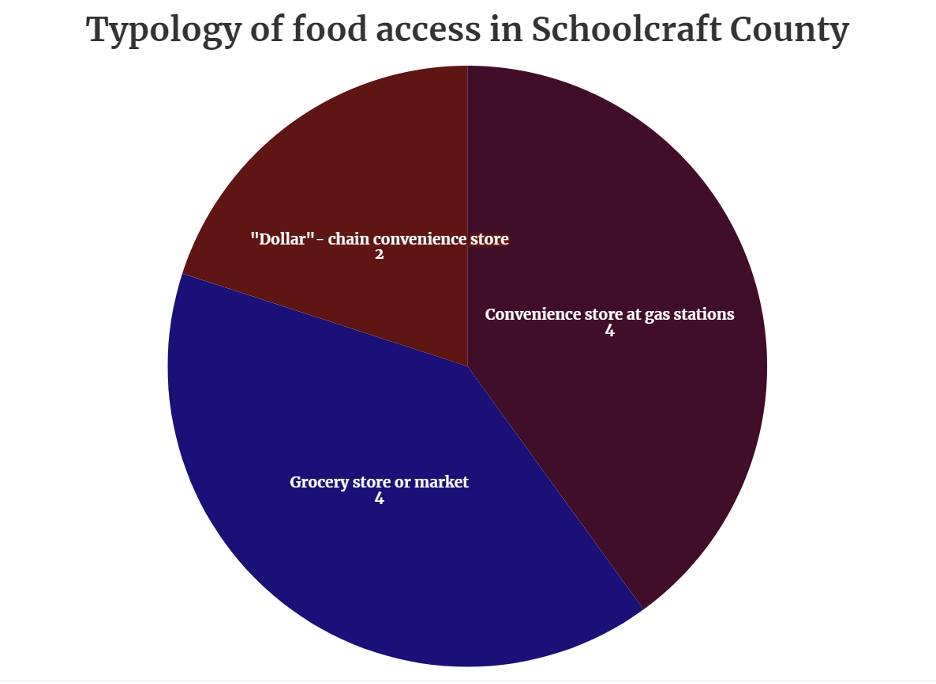A Food Access Model in Michigan’s Graying America
In Michigan’s Schoolcraft County, the weekly grocery run is complicated when the nearest big-box grocery store, a Walmart, is roughly 54 miles from the county’s most populated town, Manistique.
Whereas in greater Michigan, the median distance to the nearest food store is less than five miles in non-rural areas. In the U.S., it’s 0.9 miles, with 40% of the U.S. population living more than one mile from a food store, according to the Economic Research Service of the U.S. Department of Agriculture.
With just 8,030 people scattered across the rural swaths of the Hiawatha National Forest, residents of Schoolcraft County are used to a different way of feeding themselves — one that relies more on subsistence growing, local support networks, and making do with fewer options.

See an interactive map of the community.
The Indigenous Model
Innovative ways of feeding the community have come from working alongside members of the Sault Ste. Marie Tribe of Chippewa Indians, said Janae Moore, a food access and public health consultant at the Michigan Department of Health and Human Services.
The indigenous population accounts for 9.3% of Schoolcraft County’s overall population. The Sault Tribe, made up of 44,000 members, lives in seven counties along the seven easternmost counties of Michigan’s eastern Upper Peninsula — Marquette to Escanaba — including land around Schoolcraft’s largest city, Manistique. The federal government recognizes the Sault Tribe’s ancestral rights to hunt and fish on the ceded lands and waters in Schoolcraft County, including parts of the tribe’s reservation located in the Hiawatha National Forest. The tribe also maintains a relationship with the state of Michigan to ensure food access for its community.
“We actually funded [the tribal members] to do hoop houses for themselves, connect water, build a fishery, and produce enough food not just for the community, but also to supply to a local grocery store,” Moore said. “It’s really about pairing their ideas and what they want with our technical assistance and skills and funding.”
In some cases, the state works well with tribes to provide the funding they need, but this still scratches the surface of the work that needs to be done, said Michelle Schulte, program director at the Inter-Tribal Council of Michigan.
“Some of the smaller tribes may not have the capacity to do the reporting that’s required, or they may not have all the resources that are required within the funding restrictions,” Schulte said. “In those particular cases, sometimes the tribes will work together, multiple tribes will work together, and with the support of Inter-Tribal Council of Michigan.”
Schoolcraft County is one of the main tribal service areas the council serves. The council develops resources with the Sault Tribe in accordance with their language and support, working collaboratively to address challenges the tribe may face, including traditional food integration and sustaining food sources.
“One of the ways that the food commodity services have improved over the last several years to support food sovereignty is that they’re trying to incorporate more traditional foods,” Schulte said. “Those original commodity foods were not as nutrient-dense and caused a number of health issues, so a lot of the commodity food programs, the tribal ones, have looked at incorporating like fish or buffalo or other kinds of traditional foods sources that are more nutrient-dense.”
Projects that help the county’s indigenous population can serve as valuable models for the rest of the area and contribute to better outcomes for a rapidly graying community.
Serving an Aging Population
Rural grocery stores across the country are dying, as NPR reported earlier this year, and Schoolcraft is no exception. In this Graying America county, nearly one in three residents (29%) is age 65 or over, while only 18% of the population is under 18. Schoolcraft’s median household income is $54,163 as of 2021, according to the U.S. Census.
In a county where most options for grocery shopping are small, local markets or convenience stores, a collection of state agencies, including the Michigan Department of Agriculture and Rural Development and Michigan Department of Health and Human Services, with Schoolcraft County’s own Health, Environment and Planning Committee; Human Services Committee; and Committee on Aging have been working to ensure residents have access to healthy and affordable foods.
Moore said an aging population coupled with a sparsely inhabited county often means difficulty accessing not only groceries but also social events. “We want them to have access to food as another way to connect with people,” Moore said.
Programs like community meals for seniors and delivery services for groceries have helped older residents stay connected to the people around them. “And that’s socialization,” Moore said. “We know for a fact that that’s critical to keeping older populations from getting Alzheimer’s, from getting dementia and for protective factors that aren’t just the things you think about — hunger and nutrition also have mental health benefits.”
“We know as we age, our risk for hypertension, heart disease, diabetes, thyroid diseases grow,” Moore said. “We also know that diet affects things like cancer, so it’s critical for them to have a healthy life and a long life, and food is essential to that and essential to decreasing medical cases.”
As to whether solutions lie in bringing shopping options like Meijer or Walmart to Schoolcraft, Moore said it’s more important to examine what kinds of programs can be tailored to fit the community’s needs.
“Big-box stores are never going to be sustainable programs,” Moore said. “So, what are the other options that the community would want?”
Moore is working with the community to figure that out.
This is part of a series of posts from students at the Michigan State University Journalism School. The students will be covering four counties around Michigan during the 2024 campaign for the Detroit Free Press working with the American Communities Project typology.
